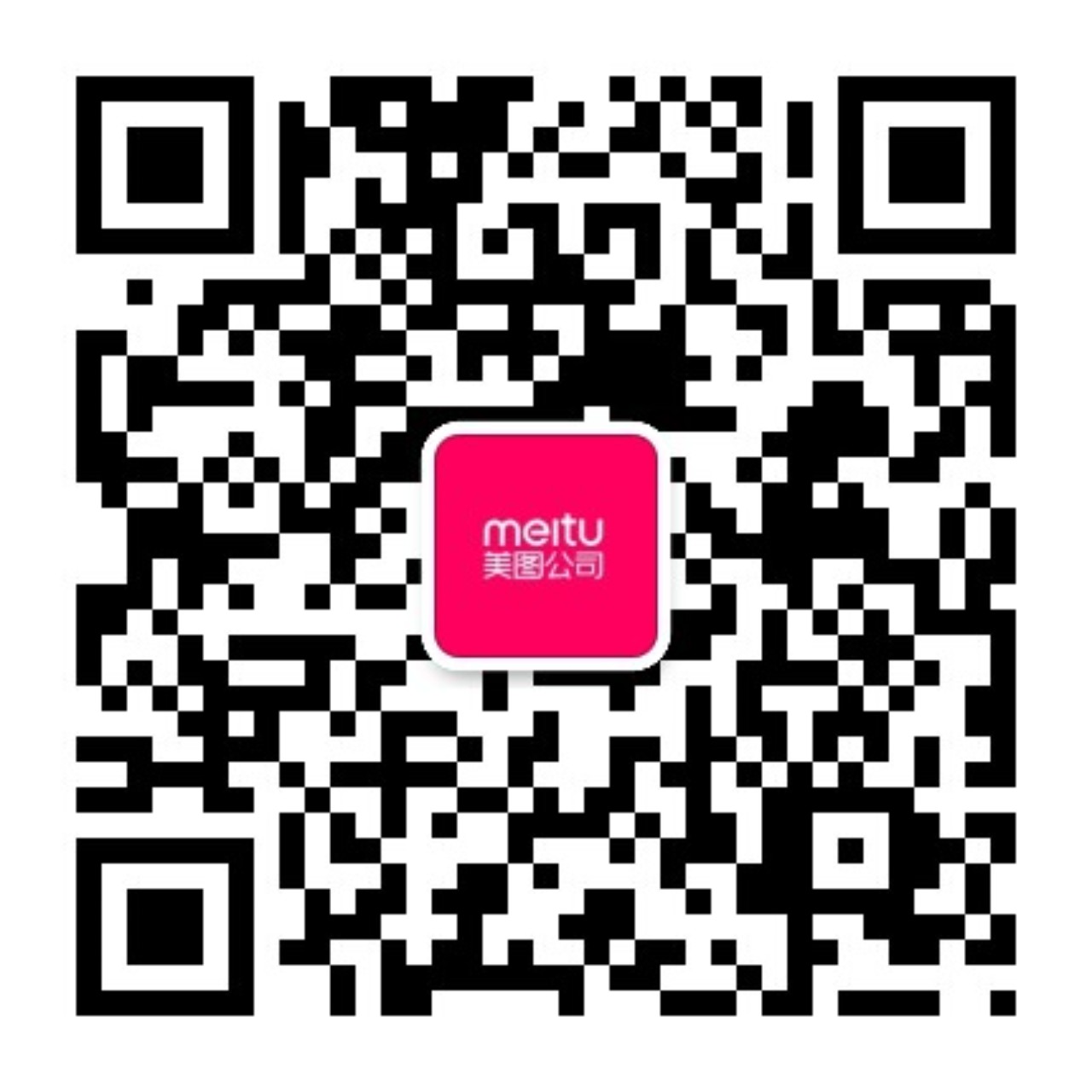Meitu's 17th Anniversary: Full Text of Wu Xinhong's Speech - Meitu's Organizational Evolution in the AI Era
2025-10-10
October 10, 2025 – During the event celebrating the 17th anniversary of Meitu Inc., Wu Xinhong, Founder, Chairman, and CEO of Meitu, delivered an internal speech and announced the company's upgraded core values to all employees: Live for Visuals, Every Pixel Counts, See Beyond Borders, Keep It Real, Challenge the Status Quo, and Strive and Thrive Together.
Here's Xinhong's full speech:
To all my fellow teammates:
Today marks Meitu's 17th birthday. I’m truly delighted—for it’s a rare opportunity—to celebrate together and talk about where we're headed next. Before we begin, I'd like to share some of my recent reflections:

First and foremost: gratitude.
I am grateful to all Meitu teammates. It is your creativity, persistence, and hard work that have driven the company's growth and transformation. At the same time, I am also grateful for the gifts of this era and for the ongoing support of our users, which has allowed us to come this far.
Second, I feel both anxious and excited.
Anxious, because generative AI has brought tremendous innovation but also fierce competition: new models and AI startup teams are springing up everywhere, constantly rewriting what we thought we knew. Excited, because we are fortunate to be part of the fourth industrial revolution, contributing our modest share to elevate human productivity.
Third, is witnessing the huge opportunity in the global imaging industry.
I spent a lot of time overseas this year. What I realized was that many countries do not enjoy China’s cost advantages born of a large population. Online and offline, numerous SMEs, content creators, and individuals overseas face high labor costs when producing or updating visual content. These exact niches can be solved efficiently by AI tools.
Speaking of this global opportunity, I have thrilling news:
Just two days ago, the Meitu app, with its AI Group Photo feature, ranked #1 in the overall App Store charts in 14 European countries, and #1 in the Camera category in 28 countries. Many mainstream European media outlets published articles about us. This is the first time our product has garnered significant attention in Europe. It's incredibly, incredibly exciting.

We’ve often discussed strategy and products. Recently, management has been asking: What should Meitu look like as an organization in the AI age?
Therefore, this is my topic today: Meitu's Organizational Evolution in the AI Era.

We just released our first-half financial report two months ago, and the results were pretty good. However, even with positive performance, we still face many challenges.
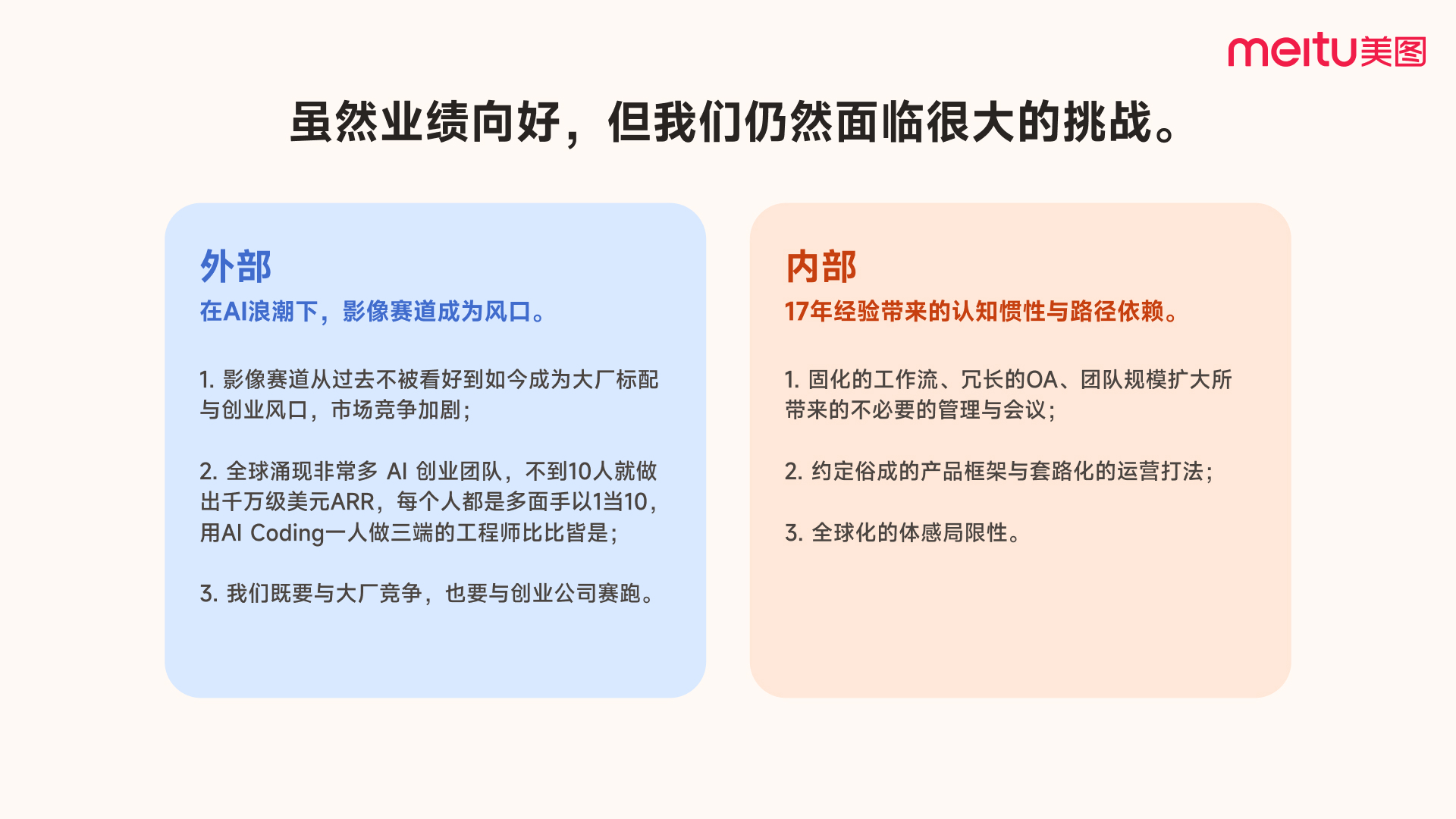
Let's first talk about the what we are facing. With the onset of the AI era, the imaging sector has become an industrial hotspot.
On one hand, imaging products have transitioned from being somewhat overlooked in the past to becoming a standard for major tech companies, with market competition intensifying. The recent popularity of “Nano Banana” shows both the deep tech reserves of top players and how a dark horse can appear at any time.
On the other hand, a large number of imaging AI startups are emerging globally. With fewer than 10 people, they can achieve tens of millions of dollars in ARR (Annual Recurring Revenue). Team members are all versatile, capable of handling multiple roles. Many AI startup engineers, using AI Coding, can handle development across three platforms (e.g., mobile, web, backend) independently, with AI full-stack engineers becoming increasingly common. By contrast, at many large internet firms, one platform—iOS, Android, or Web—may still require thirty or forty engineers. A three-platform team can easily exceed one hundred people.
Therefore, in the current market environment, we must compete both with large companies and race against agile startups.
Internally, 17 years of success have baked in cognitive inertia and path dependence: rigid workflows, bloated management and meetings resulting from team size expansion, formulaic marketing playbooks, and a limited instinct for globalization—all of these can hinder our ability to innovate.
Look at these examples we all know too well:
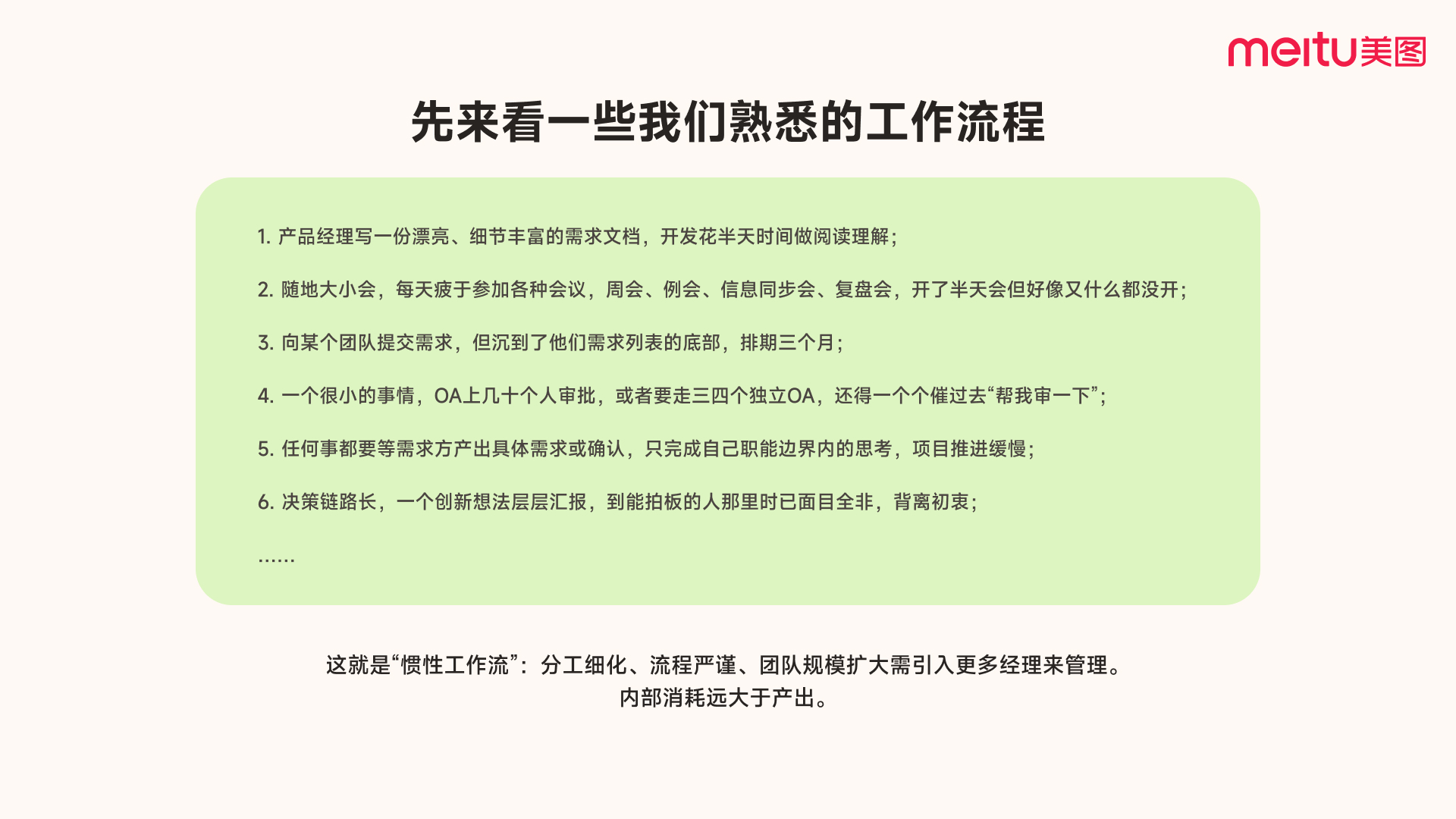
A product manager writes a beautiful, detail-packed requirements document, only for developers to spend half a day doing "reading comprehension".
Meetings, meetings everywhere - weekly meetings, regular meetings, sync-ups, retrospectives... Spend half a day in meetings, but feel like accomplishing nothing.
File a request to another team and it sinks to the bottom of their backlog—three-month wait.
Even a tiny matter needs dozens of OA approvals, sometimes several parallel/repetitive OA submissions, plus private pleas: "Please approve me." If each approver takes an hour, added up, a process can be stuck for three days.
For many tasks, everyone waits for the requester to write a complete requirements document before starting work. Each person thinks only inside his or her function, and projects crawl as a result.
Any bold idea must climb the report ladder first, and by the time it reaches the decision-maker, it is unrecognizable, its original soul lost.
This is the price of “inertial workflow”.
Finer division of labor and ever more complex processes demand more managers, so internal friction often exceeds real output.
Can we work differently?
In the past few months, due to tight project timelines and limited resources, we experimented with an "Anti-Inertia Workflow" in the RoboNeo project.

Results were encouraging: we completed global release after just one month of closed development. No traffic funneled from other Meitu products, zero PR budget. Yet, we achieved over one million MAU in the first month after launch and entered App Store category top 10 in dozens of countries globally.
What exactly did we do differently?

First, co-creating requirements.
Instead of "one writes spec, another executes", we agreed only on the big direction. R&D and design started simultaneously, iterating through high-frequency collaboration instead of heavyweight documents.
Second, slash meetings and shorten decision chains.
All weekly or sync-up meetings that produced no decision were canceled. Information flows via docs or chat. When issues arise, a quick huddle decides on the spot. Short decision chains let ideas prove themselves fast.
Thrid, use AI to turn every role into a generalist.
Tasks like translation, copywriting, requirement organizing, and building design knowledge bases were all enhanced using AI. Team members backfilled one another. Designers, PMO, and engineers all doubled as product managers. Even all overseas operations work was handled by just one person, whereas in traditionally this would require at least two or three people.
Fourth, everyone contributes.
Leaders were explicitly required to get personally involved and handle specific tasks - no "pure delegators" allowed.
Finally, building the MVP in the Shortest Time.
We emulated start-ups: Focused on core features and first released a minimal lovable product, we then iterated quickly based on user feedback. Truly "learning war through warfare." Truly "learning war through warfare."
Moreover, RoboNeo’s Agent framework opened a super-fast path for effect innovation:
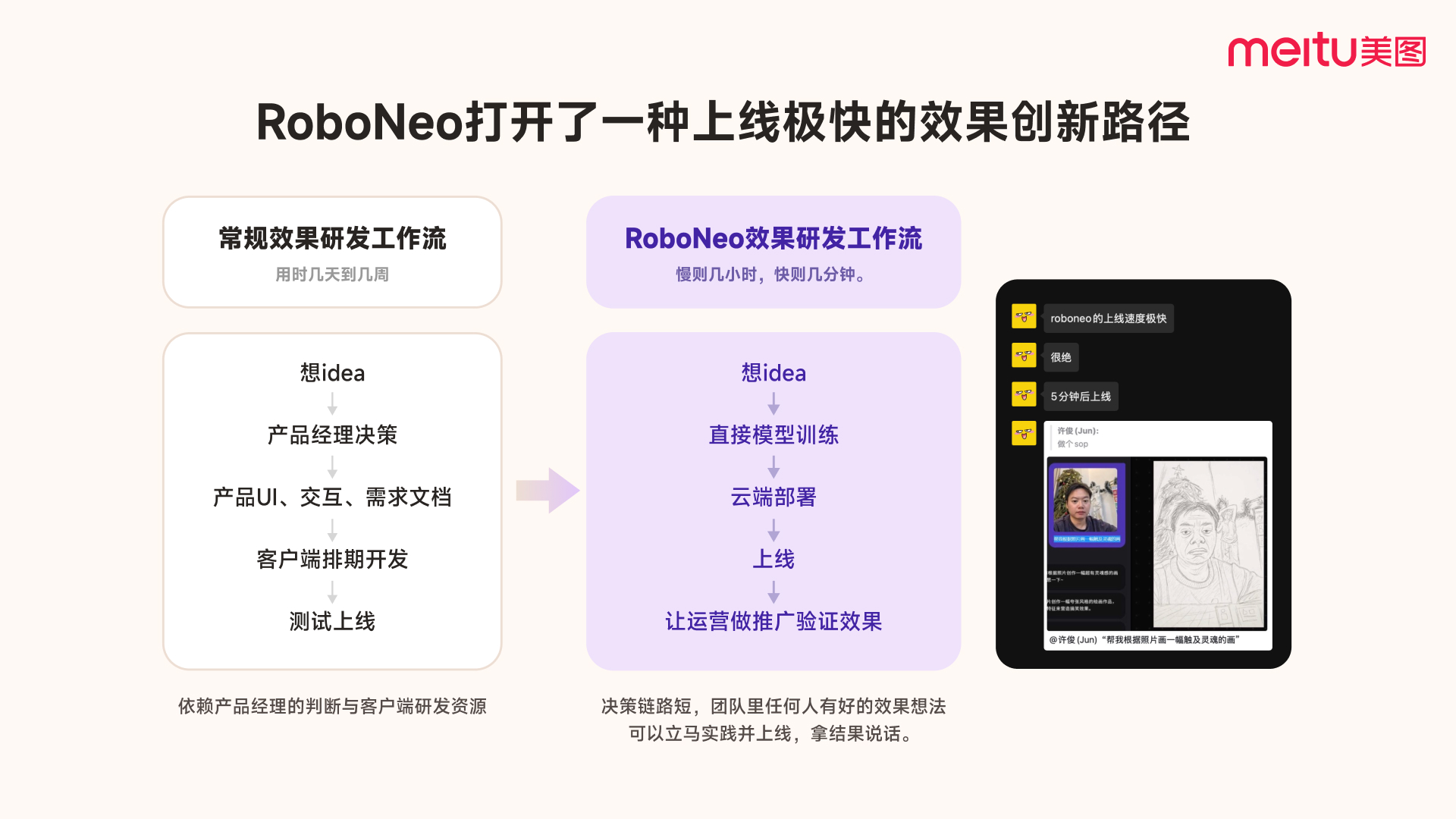
In the past, our effect R&D workflow was like this:
Designers and product managers would first brainstorm ideas. Because it involved product scheduling and R&D investment, product managers needed to make decisions, write requirements documents, and then hand them over to development, followed by testing before launch. The whole process is highly dependent on PM judgment and client R&D resources.
We tried something totally different with RoboNeo. With front-end effects flexibly configurable via Prompt and standardized deployment, designers could proceed directly to model training and deploy the effect online once they had ideas. They would then collaborate with ops on small-scale promotion and feedback.
What used to take days or weeks now takes hours—or minutes. Consider this chat log, for example. A designer can take a "soul-touching painting" effect online in just five minutes. Ideas can now be validated very quickly.
I just used RoboNeo as an example to showcase some of our attempts at organizational innovation. So, in the AI era, how do other start-ups work? Let me read you a blog post from one of these companies:
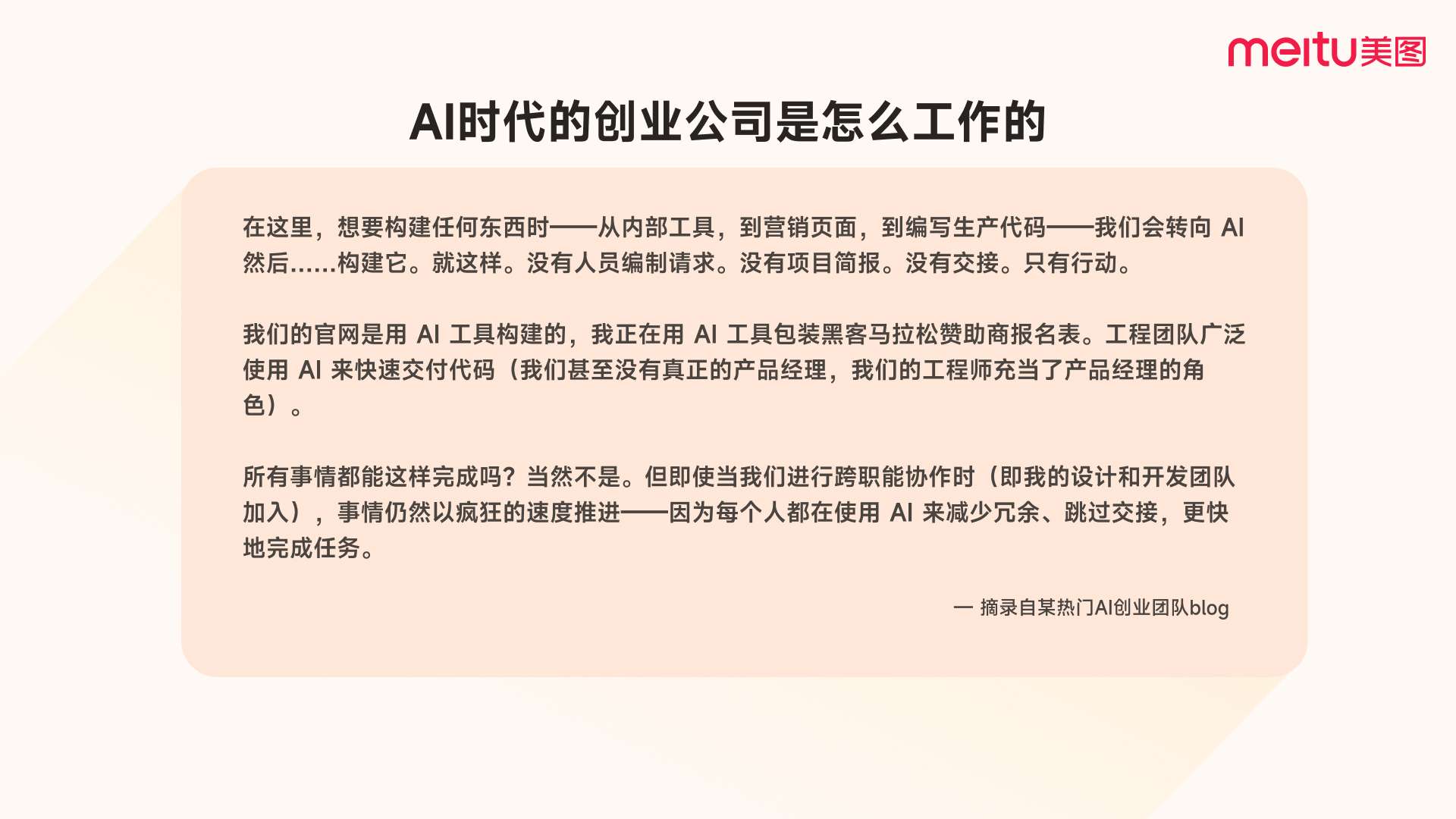
"Here, whenever we want to build anything—internal tools, marketing pages, production code—we turn to AI. No head-count requests, no project briefs, no hand-offs—only action.
Our website was built with AI tools. I'm using AI to wrap a hackathon sponsor form. Engineers ship code fast with AI. We don't even have real PMs, engineers act as PMs.
Can everything be done this way? Of course not. But even when we do cross-functional collaboration, i.e., my design and dev teams join in, things still move forward at a crazy pace. Because everyone is using AI to reduce redundancy, skip handovers, and get tasks done faster."
They call themselves an "AI-native organisation": a handful of people who continually learn and apply the latest AI tools to complete tasks that once required multiple functions and steps.
Many of you may ask: how should we prepare ourselves for the AI era?
I believe every Meitu employee must embrace AI productivity tools, moving toward the principles of "everyone is a generalist" and even "one person is one team."

Currently, we have integrated AI into key scenarios such as R&D, design, and operations:
In AI Coding, the company has introduced various AI programming tools. The adoption rate of AI coding has now reached 86%. In the future, we hope that with the help of AI, we can cultivate at least hundreds of AI full-stack engineers capable of spanning front-end, back-end, and even delving into product design.
In AI Design, our design center now leverages AI across the entire workflow, spanning from inspiration and previewing effects to generating and applying image/video assets. AI supports not only visual and effect design but also light coding, market research, and other steps, resulting in an overall efficiency improvement of over 50%. Our goal is to let every Meitu designer grow into a "super designer" mastering multiple skills.
In AI Marketing, AI has fully empowered some of our pilot operations, from seed outreach and partner screening to creative generation and performance tracking. We look forward to the Meitu market operations team growing into true "full-stack product ambassadors."
Additionally, the company has developed a range of internal infrastructure, including an AI Agent platform, MCP service platform, and AI translation platform, to help everyone get started quickly and use AI tools more efficiently.
We advocate a "handle quick tasks yourself" mindset and encourage everyone to use AI tools. For example, simple material design, copywriting, translation, and other needs can all be efficiently completed with AI. But it's also important to remind everyone to avoid blindly copying AI output, which can make it feel "obviously AI." AI is only meant to assist, and our creative thinking and professional judgment are still ultimately needed.
Also, to seize new AI opportunities in vertical imaging sectors, we have launched an internal mechanism called "AI Innovation Studio". Colleagues with creative ideas can leverage company resources to form small-scale teams and bring their product ideas to life.
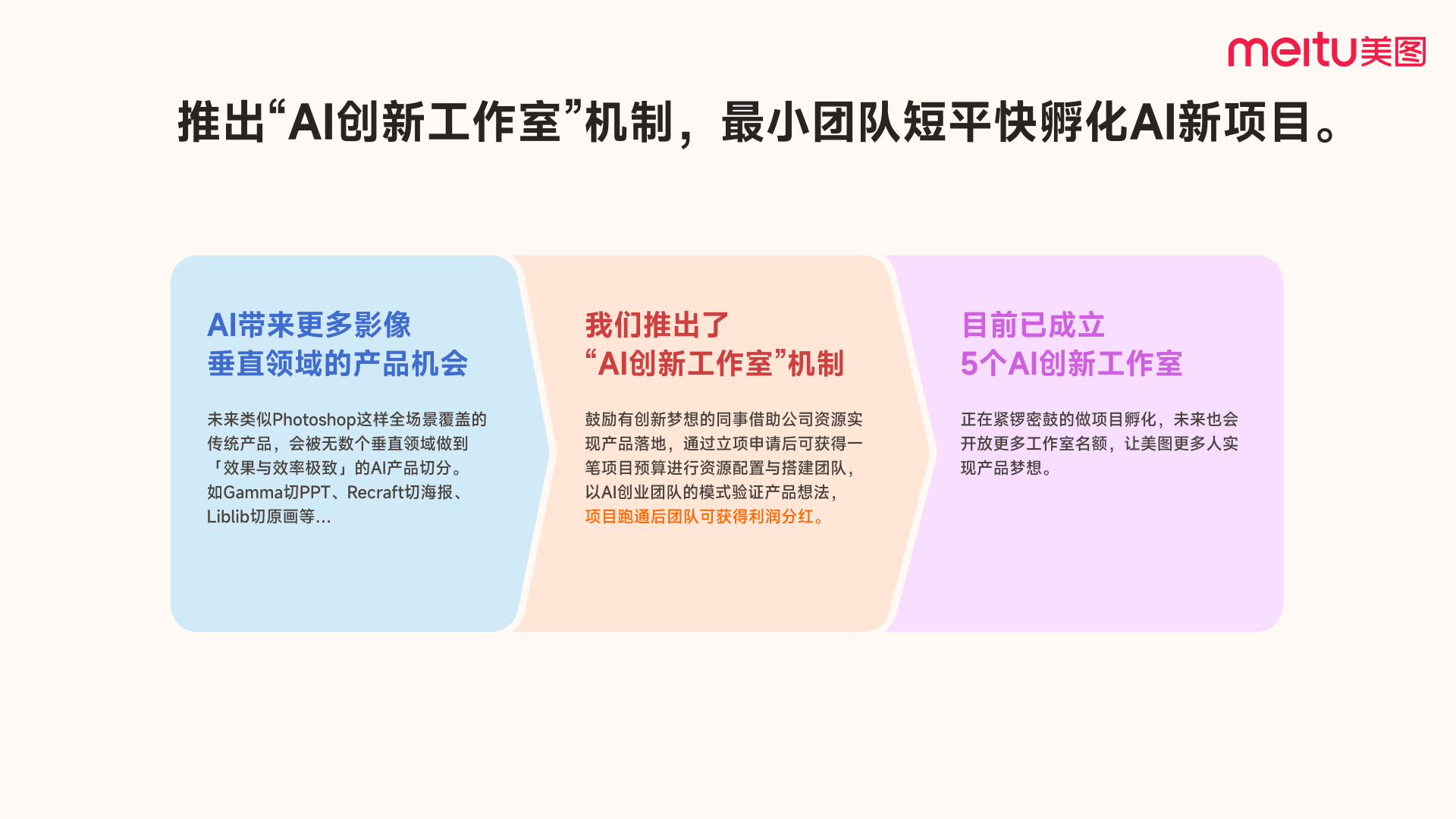
Teams that pass project review will receive an initial project budget, enabling them to independently allocate manpower and promotional resources and operate in a startup-like model to validate their product ideas. Once the project gains traction, core team members will also be eligible for profit sharing, incentivizing everyone to turn their vision into reality.
Five such studios are already incubating now, with more seats opening in the future. Everyone with product ideas is invited to turn them into reality.
In the AI era, product presentation and innovation methods have undergone significant changes. So I kept asking myself: What kind of organization should Meitu become? Here's my answer: we must be both agile and systematic, powered by a strong self-driven culture.
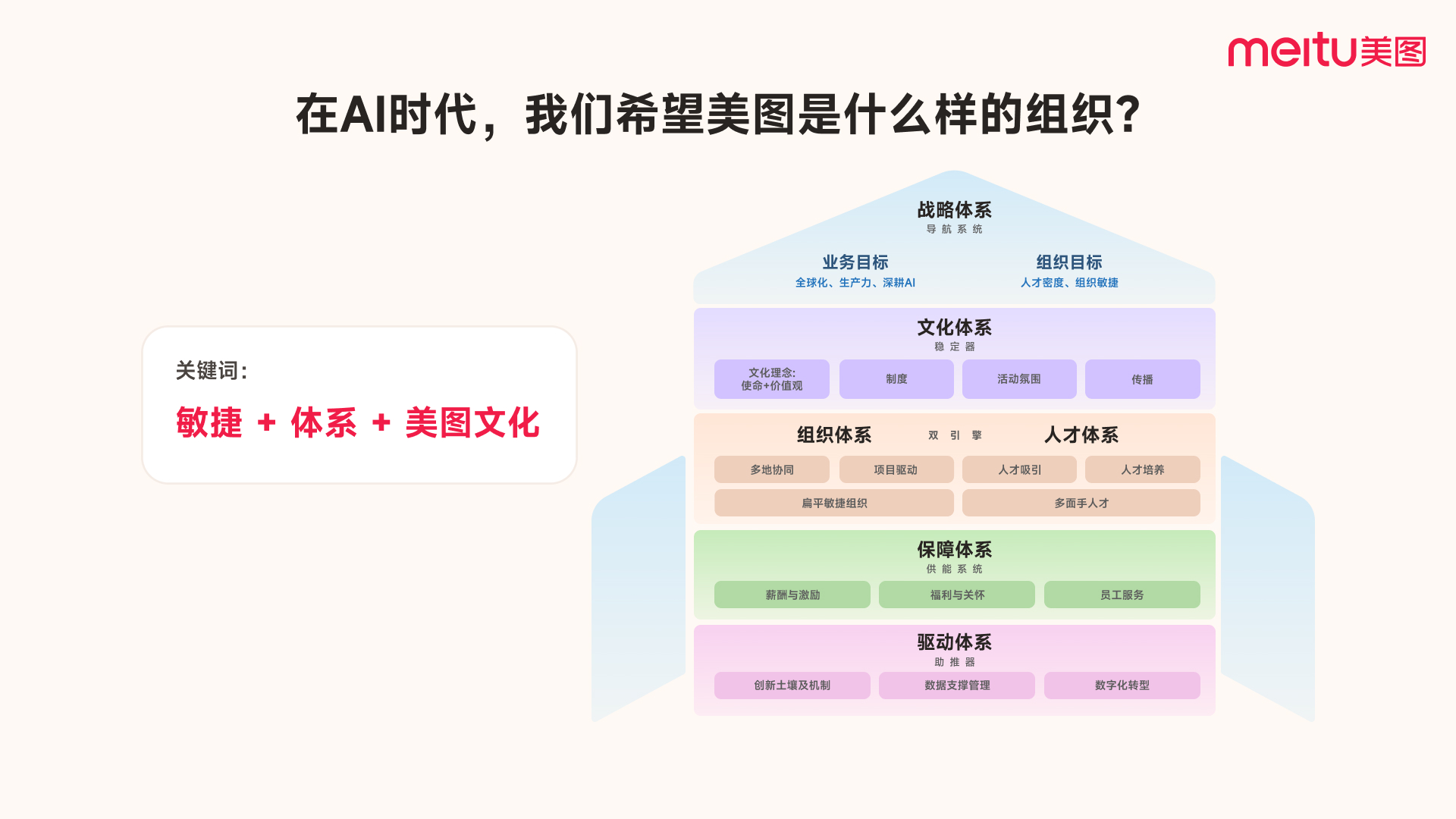
This might sound contradictory, but the two concepts are actually mutually complementary.
Agile means being anti-formulaic, maintaining sharp user insight, being sensitive to industry changes, and daring to make trade-offs.
Systematic means that in organizational and talent management, we need to be more professional and systematic, designing mechanisms and initiatives that truly stimulate the vitality of our team.
Think of us as an accelerating rocket:
The "Strategic framework" is our navigation, telling us where to go;
the "Organization and Talent System" is a dual-core engine, providing us with the power to achieve strategic goals;
the "Support and Drive System" is the power supply and booster, providing both a safety net and accelerating our progress;
and the "Cultural System" is our stabilizer, determining whether we can fly steadily towards the target.

In May, we conducted a culture survey, collecting 1,832 valid responses and conducting 37 deep-depth interviews. Many insights emerged, but one comment struct me deeply: “What carry Meitu through the cycles is our culture. "
Indeed, culture is our soft power—the glue that keeps us together and enables us to go the distance.
Culture not only accounts for how we have come all the way to where we are today, but also gives us the confidence to keep our footing and go further when facing future challenges.
Therefore, today, we are officially releasing the company's upgraded core values to all Meitu employees: Live for Visuals, Every Pixel Matters, See Beyond Borders, Keep It Real, Challenge the Status Quo, and Strive and Thrive Together.
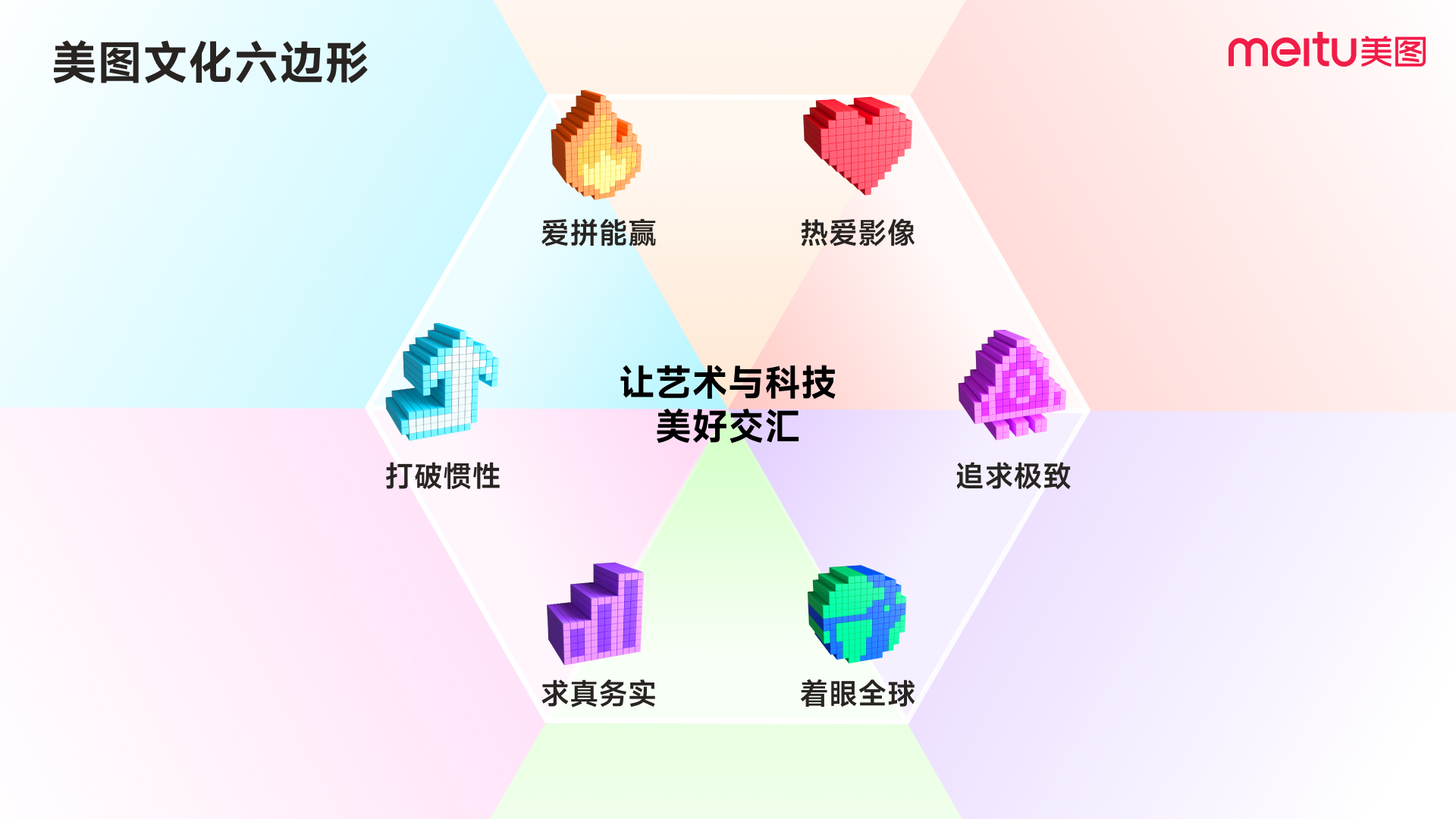
These six dimensions together form the Meitu cultural hexagon and support our mission: Unite Art and Technology.
Why a hexagon? Hexagons are nature's best answer: they use the least material, have the most stable structure, and can store the most energy.
For Meitu, the Cultural Hexagon serves as the basic framework of a honeycomb, providing stability and direction for the entire organization. Meanwhile, the AI Innovation Studios function as active individual cells within this framework, constantly incubating new products and possibilities. Each small team is like a cell in the honeycomb, capable of independent exploration yet able to combine quickly, maintaining overall agility and systematization.
So, when we say "Meitu Culture Hexagon," we are essentially saying that culture makes us strong, and mechanisms make us enduring. Meitu aims to become such a hive-like organization: stable, orderly, efficient, and capable of continuously nurturing new possibilities.
This cultural launch is not a “overhaul” but an “upgrade.” Because all along, we have loved imaging, always pursued excellence, continuously broken conventions, and advanced globally... these traits are already deeply rooted in us.
So, how should we understand these upgraded values? Let me briefly explain each:
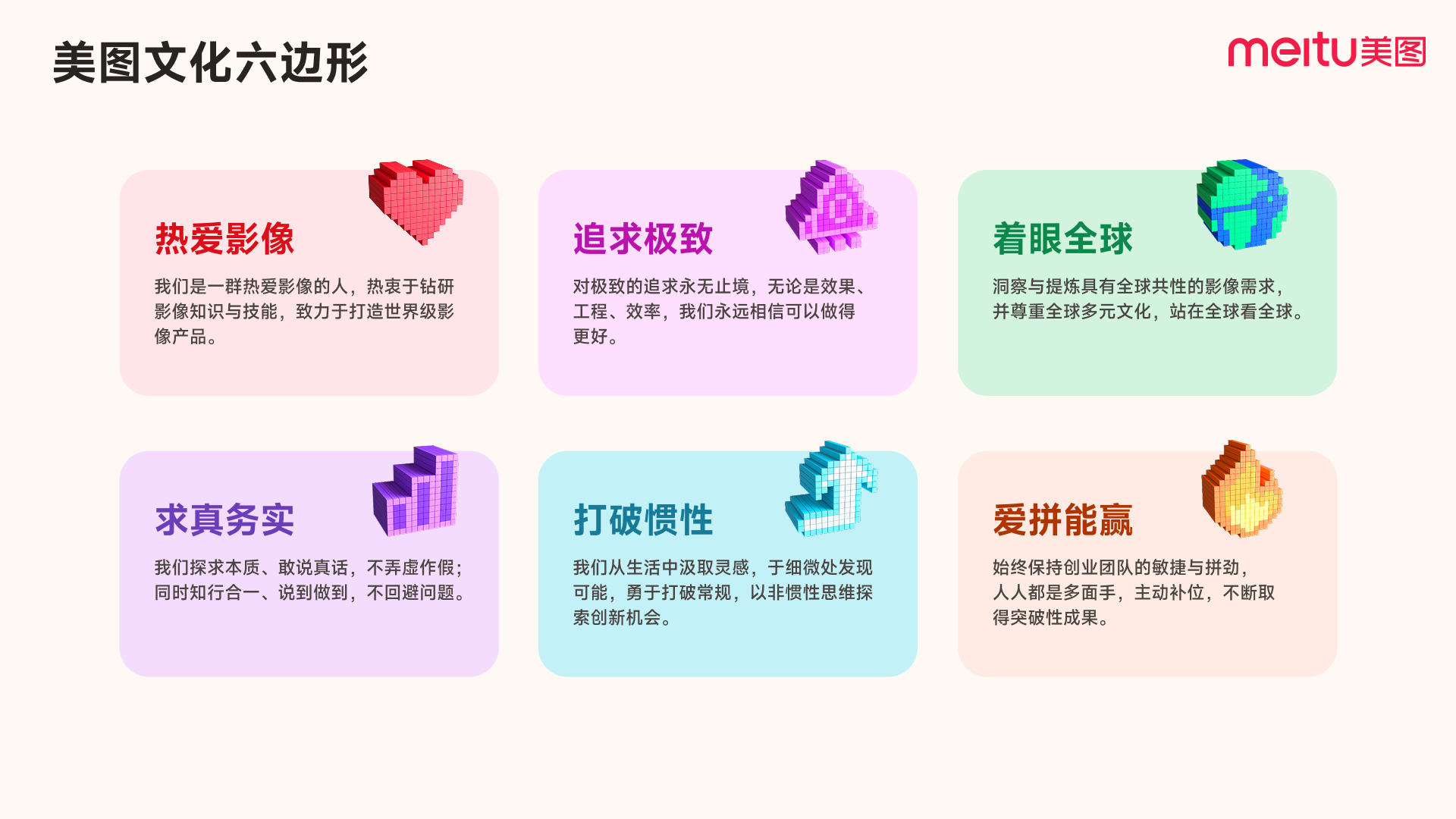
Live for visuals - We are a team of imaging enthusiasts, dedicated to studying imaging knowledge and skills to create world-class imaging products.
Every Pixel Matters - We take pride in our endless pursuit of excellence. Whether in quality, engineering, or efficiency, we always believe we can do better.
See Beyond Borders - We identify universal imaging needs, respect diverse cultures, and think globally.
Keep It Real - We seek truth, speak honestly, and act with integrity. We follow through on our commitments and tackle challenges head-on.
Challenge the Status Quo - Inspired by everyday life, we identify opportunities in the details. We challenge traditions and innovate through unconventional thinking.
Strive and Thrive Together- We maintain the agility and motivation of a start-up. Our team members are versatile, step in proactively when needed, and consistently make breakthroughs.
The Cultural Hexagon is not about being perfect in all six aspects, but about continuous growth, and becoming more well-rounded.
The cultural values concretely describe "what the Meitu team should be like" and are the code of conduct and action roadmap for all Meitu teammates. Driven by them, I look forward to us becoming a better team together.

Here, I also invite everyone to actively participate in the cultural workshops within your team. Let's work together to define specific behavioral guidelines and allow our culture to truly take root and thrive.
Of course, company culture cannot rely solely on slogans, it needs to be implemented through tangible mechanisms.

To ensure everyone can focus on their work and self-improvement with peace of mind, the company will also strive to provide strong support.
We have established the "Meitu Spark Academy," a program designed to host regular training sessions. Let's all step onto the stage and share our expertise. Whether it's product insights or global experience, every lesson deserves to be captured and passed on.
I hope we can all share the passion for visuals, and I'm confident that we have many "closet photo ninjas" amongst us. That's why we're launching a company-wide photo contest, and we want you all in! Even more importantly, even if you're not a seasoned pro, I still hope you can discover the joy in imaging.
We also plan to continuously strengthen our investment in company benefits that are more flexible to cater to individual needs. HR will release a detailed plan later.
We will continue to listen to your voices, as all changes are a joint effort rather than one-way directives. We are launching an annual employee satisfaction survey. Whether regarding culture or any other aspect of the company, we invite everyone to speak freely and shape the company's future together.
Finally, I want to say this to all of you:

Let's seize this once-in-a-lifetime opportunity that the AI era has afforded us. By fully embracing our ideals of "Live for Visuals, Every Pixel Matters, See Beyond Borders, Keep It Real, Challenge the Status Quo, and Strive & Thrive Together", let's keep building world-class imaging products together!
Thank you.

